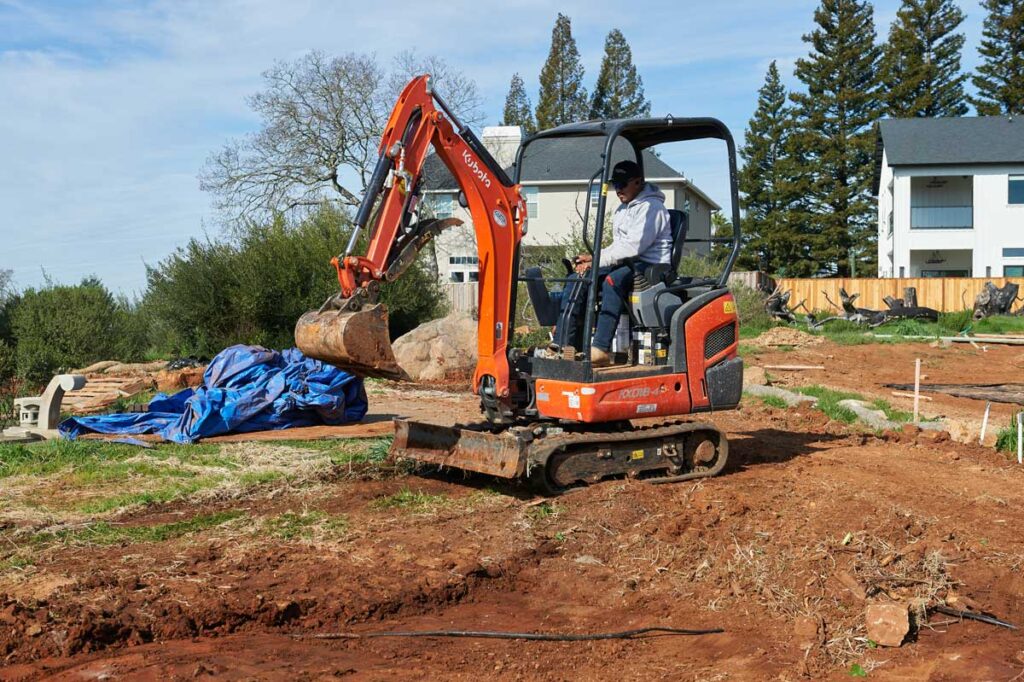Gardening enthusiasts and DIY home improvers often dream of creating the perfect outdoor space. Whether you’re planning a major garden revamp or just want to add some new features, an excavator can be an invaluable tool for your home improvement projects. In this blog post, Qainzhi Machinery will explore how using an excavator can enhance your gardening efforts, save you time, and help you achieve professional results. From digging ponds to preparing new flower beds, an excavator might just be the secret weapon your garden needs.
Using an excavator for gardening projects can significantly speed up the process and provide precision that’s hard to achieve with manual labor. These powerful machines are designed to handle heavy-duty tasks that would otherwise take days or even weeks to complete by hand. Not only do they save time, but they also reduce the physical strain on gardeners, allowing you to focus more on the creative aspects of your project.
One of the primary benefits is efficiency. An excavator can dig, move, and place large amounts of soil, rocks, and other materials quickly and accurately. This means you can prepare your garden for planting, build structures, and modify the landscape in a fraction of the time it would take using traditional methods.
Additionally, excavators are versatile. They come with various attachments and sizes, making them suitable for a wide range of gardening tasks. Whether you need to dig deep holes for trees, remove old stumps, or create a level surface for a patio, there’s an excavator designed to do the job efficiently.
Selecting the right excavator for your gardening project is crucial to achieving the desired results. There are several factors to consider, including the size of your garden, the type of soil, and the specific tasks you need to accomplish. These factors will help you choose the best machine for the job.
First, consider the size of your garden. For smaller gardens, a mini excavator might be the best option. These compact machines can maneuver in tight spaces and are less likely to cause damage to your existing plants and structures. They are also easier to transport, making them ideal for residential projects.
Next, think about the type of soil in your garden. If you have loose, sandy soil, a lightweight excavator with a bucket attachment might be sufficient. However, for rocky or clay-heavy soil, you may need a more robust machine with stronger digging capabilities. This ensures that the excavator can handle the demands of your project without getting stuck or causing unnecessary wear and tear.
Lastly, consider the specific tasks you need to accomplish. Some excavators come with specialized attachments, such as augers for drilling holes or hydraulic breakers for breaking up concrete. Choosing an excavator with the right attachments can make your project more efficient and help you achieve professional-quality results.
Before you start using an excavator in your garden, it’s essential to prepare the area properly. This involves clearing any obstacles, marking out the areas you plan to excavate, and ensuring that the ground is stable and safe for heavy machinery. Proper preparation can prevent accidents and ensure that your project runs smoothly.
Start by clearing the area of any debris, such as branches, rocks, and old plants. This not only makes it easier to maneuver the excavator but also prevents damage to the machine and reduces the risk of accidents. Removing obstacles beforehand also allows you to see the layout of your garden more clearly and plan your excavation more effectively.
Next, mark out the areas you plan to excavate. Use stakes and string or spray paint to outline the boundaries of your project. This helps you stay within the designated area and prevents you from accidentally digging in the wrong spot. Accurate marking is especially important for larger projects, such as building ponds or installing irrigation systems, where precise measurements are crucial.
Finally, ensure that the ground is stable and safe for the excavator. Check for any underground utilities, such as gas lines or water pipes, and make sure they are clearly marked. It’s also a good idea to contact your local utility company to confirm the location of any underground services. By taking these precautions, you can avoid costly damages and ensure a safe working environment.
Adding a pond or water feature to your garden can create a tranquil and visually appealing focal point. Using an excavator makes the process of digging ponds much more manageable, allowing you to achieve the desired depth and shape with precision. Whether you’re creating a small koi pond or a large naturalistic water feature, an excavator can help you bring your vision to life.
Begin by planning the location and design of your pond. Consider factors such as sunlight, drainage, and accessibility when choosing the site. A well-planned location ensures that your pond thrives and integrates seamlessly into your garden. Sketch out the shape and dimensions on paper to serve as a guide during excavation.
Once you have your plan, use the excavator to start digging. Begin at the center and work your way outward, gradually deepening the pond. This method helps maintain stability and prevents the walls from collapsing. If your pond has multiple levels or shelves, use the excavator to carve out these features as you dig. The precision of the excavator allows you to create smooth transitions and well-defined edges.
After digging, you can use the excavator to move and place rocks, soil, and other materials around the pond. This is particularly useful for creating natural-looking edges and integrating the pond into the surrounding landscape. With the bulk of the heavy lifting done, you can focus on adding plants, installing a pump, and stocking the pond with fish.
Raised garden beds offer several advantages, including improved soil quality, better drainage, and easier access for planting and maintenance. Using an excavator to construct raised beds can save time and effort, allowing you to create sturdy and attractive structures that enhance your garden’s functionality and aesthetics.
Start by selecting a suitable location for your raised beds. Ensure that the area receives adequate sunlight and is easily accessible. Mark out the dimensions of the beds using stakes and string or spray paint. This gives you a clear outline to follow during excavation.
Next, use the excavator to dig out the foundation for the raised beds. Remove any existing grass or vegetation and level the ground to provide a stable base. Depending on the height of your raised beds, you may need to excavate deeper to accommodate the layers of soil and compost you plan to add.
Once the foundation is prepared, you can use the excavator to move and place materials for constructing the raised beds. Common options include wood, stone, or concrete blocks. The excavator’s precision allows you to position these materials accurately, ensuring that your raised beds are level and secure. After construction, fill the beds with high-quality soil and compost, ready for planting.
Old tree stumps and shrubs can be a significant obstacle when redesigning your garden. Removing them manually can be time-consuming and labor-intensive. An excavator simplifies this process, allowing you to clear your garden of unwanted stumps and shrubs quickly and efficiently, making way for new plantings and features.
Begin by assessing the size and condition of the stumps and shrubs you need to remove. Smaller stumps and shrubs may only require a mini excavator, while larger, more stubborn roots might need a full-sized machine. Choosing the right excavator ensures that you can tackle the job effectively and safely.
Use the excavator to dig around the base of the stump or shrub, exposing the roots. This process loosens the soil and makes it easier to pull the stump or shrub out completely. For larger stumps, you may need to cut through some of the thicker roots using a chainsaw or pruning saw. The excavator’s hydraulic arm provides the force needed to lift and remove the stump or shrub from the ground.
After removal, fill the hole with soil and level the area. This leaves a clean slate for new plantings or landscaping features. Removing old stumps and shrubs not only improves the appearance of your garden but also prevents potential issues with pests and diseases that can harbor in decaying wood.
Terracing and creating sloped gardens can add depth and visual interest to your landscape. These features are also practical, helping to prevent soil erosion and improve drainage. Using an excavator allows you to shape and sculpt your garden with precision, creating beautiful terraces and slopes that enhance both form and function.
Start by planning the layout of your terraces or sloped garden. Consider the natural contours of your land and how you can work with them to create a harmonious design. Sketch out the levels and transitions on paper to serve as a guide during excavation.
Use the excavator to carve out the terraces, starting from the bottom and working your way up. This method ensures stability and prevents the soil from collapsing. Create level platforms at each terrace, making sure they are wide enough to accommodate planting beds, pathways, or seating areas.
For sloped gardens, use the excavator to shape gentle slopes and curves that blend seamlessly with the surrounding landscape. The precision of the excavator allows you to create smooth transitions and well-defined boundaries. After shaping the terraces and slopes, you can use the excavator to move and place rocks, retaining walls, and other materials to reinforce the structure and add visual interest.
An efficient irrigation system is essential for maintaining a healthy garden, especially during dry seasons. Installing an irrigation system can be a complex task, but an excavator can make the process much more manageable. From digging trenches for pipes to creating spaces for water tanks, an excavator helps you set up a reliable and effective watering system.
Begin by planning the layout of your irrigation system. Determine the best locations for pipes, valves, and water sources. Mark out the paths for trenches using stakes and string or spray paint. Accurate marking ensures that your irrigation system covers all areas of your garden effectively.
Use the excavator to dig trenches along the marked paths. The precision of the excavator allows you to create straight, even trenches that are the correct depth for your pipes. This ensures that the pipes are well-protected and function efficiently.
After digging the trenches, lay the pipes and connect them to the water source and valves. The excavator can also be used to dig holes for water tanks or other large components of your irrigation system. Once everything is in place, use the excavator to backfill the trenches and level the ground. This leaves your garden looking neat and ready for planting.
Healthy soil is the foundation of a thriving garden. Over time, soil can become compacted, depleted of nutrients, and less capable of supporting plant growth. Using an excavator allows you to enhance soil quality by turning and aerating the soil, mixing in compost and other amendments, and preparing the ground for new plantings.
Start by assessing the condition of your soil. Perform a soil test to determine its composition and identify any deficiencies. This information helps you choose the right amendments to improve soil quality.
Use the excavator to turn and aerate the soil. This process breaks up compacted areas, increases oxygen levels, and promotes healthy root growth. The excavator’s bucket can also be used to mix in compost, manure, and other organic matter, enriching the soil with essential nutrients.
After enhancing the soil, you can use the excavator to create planting beds, mounds, and other features that improve drainage and support plant growth. Preparing the soil properly sets the stage for a successful and vibrant garden.
Garden paths and patios provide structure and accessibility to your outdoor space. They also add aesthetic appeal and create defined areas for different activities. Using an excavator allows you to build sturdy and attractive paths and patios quickly and efficiently, enhancing the overall layout and functionality of your garden.
Begin by planning the layout of your paths and patios. Consider how they will connect different areas of your garden and how they will be used. Mark out the paths and patio areas using stakes and string or spray paint to create a clear outline.
Use the excavator to dig out the foundation for your paths and patios. Remove any existing vegetation and level the ground to provide a stable base. Depending on the materials you plan to use, you may need to dig deeper to accommodate layers of gravel, sand, or concrete.
Once the foundation is prepared, use the excavator to move and place materials for constructing the paths and patios. Common options include pavers, bricks, stones, or concrete slabs. The precision of the excavator allows you to position these materials accurately, ensuring a smooth and even surface. After construction, fill any gaps with sand or gravel and compact the surface to create a durable and attractive finish.
Planting trees and large shrubs can transform your garden, adding height, structure, and visual interest. Using an excavator to dig holes for planting makes the process much more manageable, allowing you to position trees and shrubs accurately and ensure they have the best chance of thriving.
Start by selecting the right locations for your trees and shrubs. Consider factors such as sunlight, soil type, and spacing. Proper planning ensures that your plants have enough room to grow and receive the necessary nutrients and light.
Use the excavator to dig holes for planting. The holes should be wide and deep enough to accommodate the root ball of each tree or shrub. The precision of the excavator allows you to create uniform holes.
After digging the holes, position each tree or shrub in the center and backfill with soil. Use the excavator to move and place soil around the base, ensuring that the plants are secure and well-supported. Water thoroughly after planting to help the roots establish and promote healthy growth.
Privacy screens and windbreaks provide protection and seclusion for your garden. They can also enhance the aesthetic appeal of your outdoor space. Using an excavator to create these features allows you to build sturdy and effective barriers that improve the functionality and comfort of your garden.
Start by planning the location and design of your privacy screens and windbreaks. Consider factors such as prevailing winds, sun exposure, and the layout of your garden. Mark out the areas where you plan to install the screens or plant the windbreaks.
Use the excavator to dig trenches for the foundations of your screens or holes for planting windbreaks. The precision of the excavator allows you to create uniform and straight trenches, ensuring that your screens are stable and secure.
Once the foundation is prepared, use the excavator to move and place materials for constructing the screens or planting the windbreaks. Common options include wooden panels, metal fencing, or rows of trees and shrubs. The excavator’s versatility allows you to position these materials accurately and efficiently.
After installation, you can use the excavator to backfill the trenches and level the ground. This leaves a clean and polished finish, enhancing the overall appearance of your garden.



